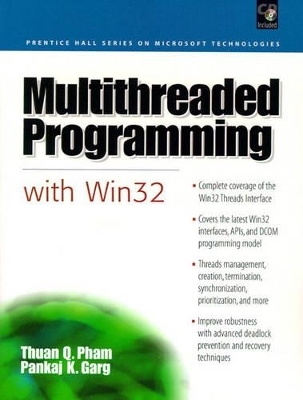
Multithreaded Programming with Win32
Prentice Hall
978-0-13-010912-5 (ISBN)
- Titel ist leider vergriffen;
keine Neuauflage - Artikel merken
Learn practical Win32 multithreading techniques that can make all your Windows NT software faster and more responsive. Start by understanding how multithreading works, and the fundamentals of the Windows NT Thread Interface, including processes, thread management, creation, termination, and prioritization. Review the key techniques Win32 provides for thread synchronization, with practical examples of how to use them most effectively. Understand the role of monitors and data encapsulation. Next, use Microsoft's deadlock detection, prevention and recovery techniques to avoid the classic conditions known to crash multithreaded systems. Learn about the thread-package architecture and implementations, including user-level, kernel-level and multiplexed threads, and the scheduler. You'll also find great coverage of Java threads -- and an exceptionally useful chapter on multithreading in distributed applications, using Microsoft's DCOM technology.
Thuan Q. Pham is a developer at Netgravity in Palo Alto, CA. Pankaj K. Garg is a Member of the Technical Staff (MTS) at HP Laboratories in Palo Alto, CA.
1. Introduction. What Is Multithreaded Programming? A Bit of History. Advantages of Threads. A Multithreaded Program Example. Challenges of Multithreaded Programming. Summary. Exercises. References. 2. Win32 Thread Interface. Processes and Threads. Thread Management Concepts. Thread Management Interface. Example Program: LineSweep. Thread Synchronization. Thread Priorities. Thread Local Storage (TLS). Summary. Exercises. References. 3. Thread Synchronization. The Producer-Consumer Problem. The Bounded-Buffer Problem. The Readers-Writers Problem. Summary. Bibliography Notes. Exercises. References. 4. Monitors. Structure of a Monitor. Data Encapsulation. Controlled Access to Data. Condition Variables. Benefits of Monitors. Using Monitors. Summary. Bibliographic Notes. Exercises. References. 5. Simulating Monitors. Simulation of Monitor Constructs. Using Monitors. Summary. Bibliographic Notes. Exercises. References. 6. Deadlock Analysis. Examples of Deadlock. System Resources. Conditions for Deadlock. The Dining Philosophers Problem. Handling Deadlocks. Deadlock Prevention. Deadlock Detection and Recovery. Deadlock Avoidance. Summary. Bibliographic Notes. Exercises. References. 7. Thread-Package Architectures. Operating System Structure. Thread Package Implementations. Summary. Bibliographic Notes. Exercises. References. 8. Programming Models. Workgroup Model. Manager-Worker Model. Deferred-Computation Model. Pipeline Model. WorkCrew Model. Summary. Bibliographic Notes. Exercises. References. 9. Threads in Distributed Applications. The Client-Server Model. Remote Procedure Call (RPC). An RPC-Based Distributed Application Example. Distributed Applications Using DCOM. DCOM-Based Phone Application. Summary. Bibliographic Notes. Exercises. References. Appendix A:WorkCrew Implementation. WorkCrew Implementation. References. Bibliography. Index.
| Erscheint lt. Verlag | 30.12.1998 |
|---|---|
| Verlagsort | Upper Saddle River |
| Sprache | englisch |
| Maße | 177 x 233 mm |
| Gewicht | 522 g |
| Themenwelt | Informatik ► Betriebssysteme / Server ► Windows |
| ISBN-10 | 0-13-010912-6 / 0130109126 |
| ISBN-13 | 978-0-13-010912-5 / 9780130109125 |
| Zustand | Neuware |
| Haben Sie eine Frage zum Produkt? |